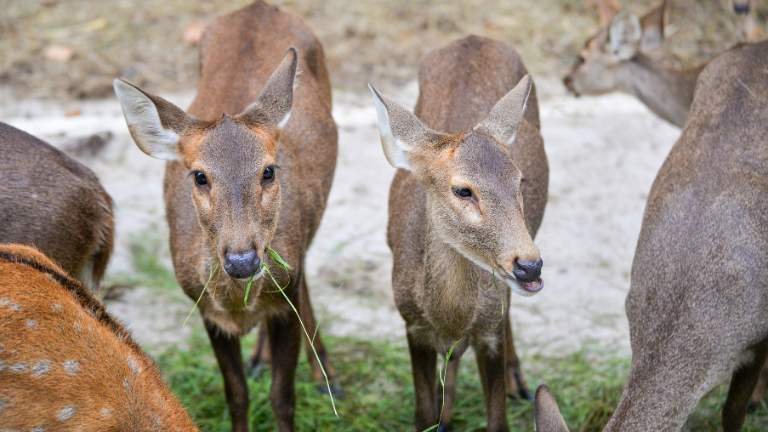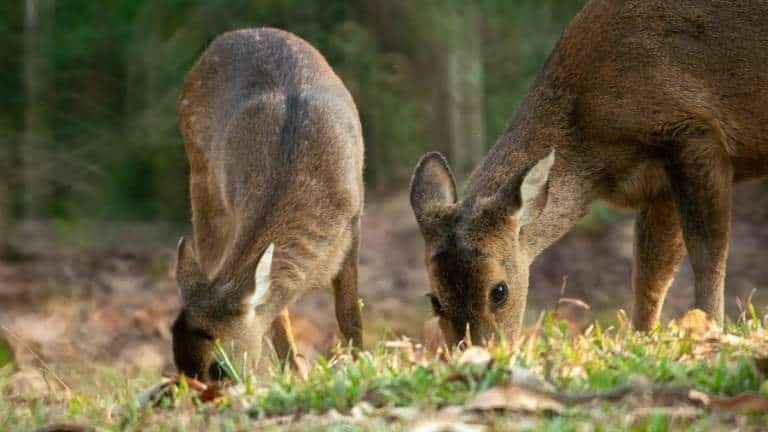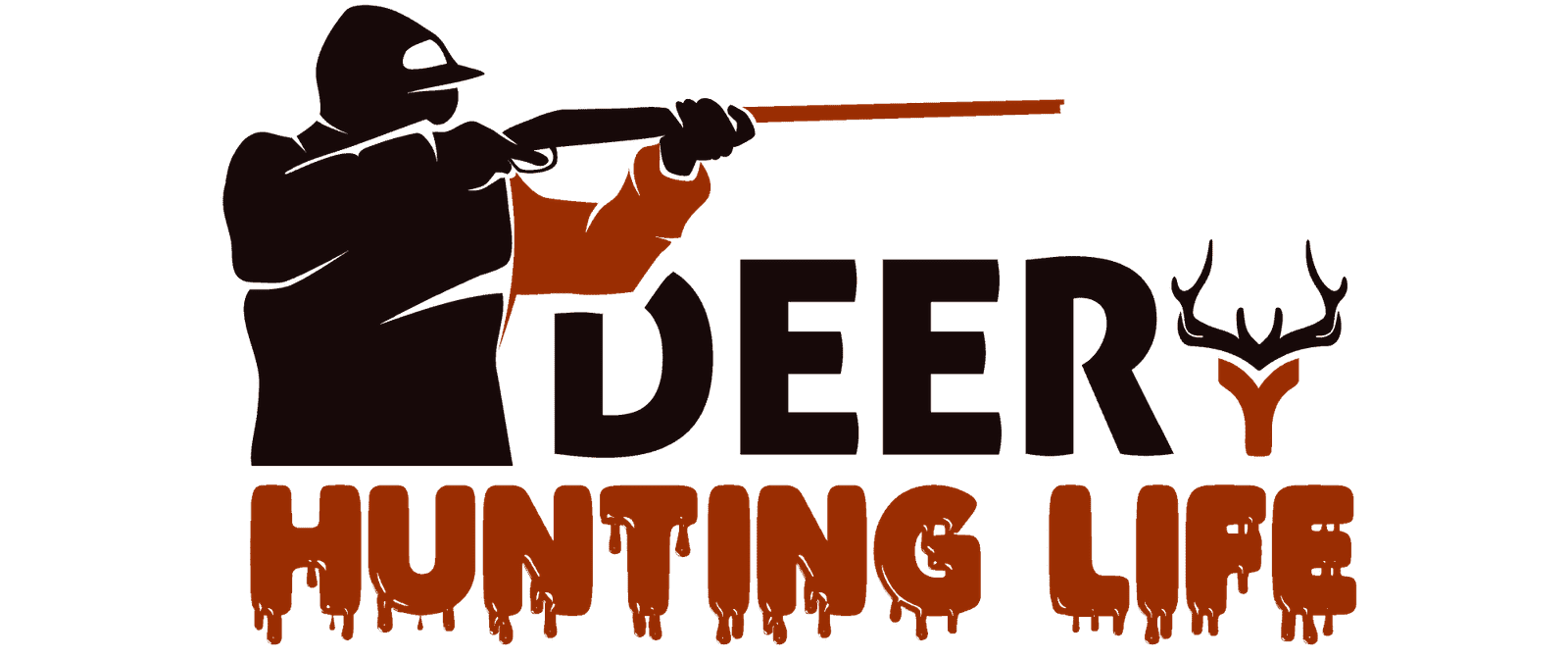Successful food plots require careful planning and diligent management. Before investing your valuable time, effort, and resources, it’s good to define the specific goals you want to achieve with your food plot. If you derive satisfaction from nurturing the land, fostering a harmonious relationship with nature, and witnessing wildlife flourish, then food plots can be a rewarding endeavor.
However, if your primary objective is to cultivate and harvest trophy animals, you might encounter frustration, as food plots alone cannot guarantee the growth of large-antlered, trophy-sized white-tailed deer. Genetic factors and the age distribution of bucks within a herd exert more influence over antler size than supplementary food sources.
It’s essential to recognize that food plots should never replace the natural wildlife foods available in your area. Instead, they should serve as a complementary component within a broader wildlife management strategy. A well-balanced approach is crucial to establishing sustainable food plots that benefit both the wildlife and your land.
To embark on this journey, you should begin by establishing realistic expectations for your food plots, taking into account your available land resources and the existing local wildlife populations. Once you’ve determined these expectations, you can then proceed to plan the number of plots, their size, ideal locations, and the specific plant species that will best serve your wildlife management objectives.

Understanding Deer Food Plots
Creating a successful deer food plot begins with a deep understanding of what these plots are, their purpose, and the numerous benefits they offer to both wildlife and landowners. In this section, we will explore the fundamental concepts of deer food plots to lay a solid foundation for your habitat enhancement efforts.
Defining Deer Food Plots
Deer food plots, at their core, are intentionally cultivated areas of land designed to provide essential sustenance for deer and other wildlife species. These plots serve as supplemental food sources, offering a reliable supply of nutrition throughout various seasons of the year. By providing a consistent and accessible food supply, deer food plots contribute to the overall well-being and health of local wildlife populations.
The Benefits of Deer Food Plots
Understanding the advantages of deer food plots is vital to appreciating their role in wildlife management:
- Enhanced Nutrition: Deer food plots supply a diverse range of forage that complements natural vegetation, ensuring deer receive the necessary nutrients for growth and survival.
- Improved Wildlife Health: A well-maintained food plot can help deer maintain better body condition, especially during challenging times like winter when natural food sources are scarce.
- Wildlife Attraction: Food plots are magnets for wildlife, drawing deer and other species to specific areas, making them ideal for observation and conservation efforts.
- Hunting Opportunities: For hunters, food plots can increase the chances of encounters with deer, providing a more controlled and ethical hunting environment.
- Habitat Enhancement: By creating diverse habitats within your property, you contribute to overall ecosystem health and biodiversity.
The Role of Deer Food Plots in Habitat Management
Deer food plots play a significant role in holistic wildlife habitat management. They are not isolated endeavours but rather integral components of a broader strategy. These plots can help:
- Improve Habitat Quality: Food plots enhance the habitat by diversifying plant species and attracting various wildlife, contributing to a healthier ecosystem.
- Support Population Health: A well-managed food plot can aid in balancing deer populations and reducing stress on natural food sources.
- Enhance Land Stewardship: As a landowner, creating and maintaining deer food plots demonstrates responsible and sustainable land management.
As you embark on your journey to create deer food plots, remember that these are not just patches of cultivated land; they are your contribution to preserving and nurturing the natural world.
Planning Your Deer Food Plot
Creating a thriving deer food plot needs careful planning and thoughtful consideration of various factors. In this section, we will guide you through the essential steps involved in planning your deer food plot, ensuring that it meets your goals and provides optimal benefits for wildlife.
Selecting the Right Location
- Factors to Consider: The first step in planning your deer food plot is choosing the correct location. Consider factors such as proximity to cover, deer travel patterns, and accessibility for both deer and yourself.
- Sunlight, Soil, and Drainage: Assess the availability of sunlight, soil quality, and drainage in the chosen area. Most food plot plants thrive in well-drained soil with adequate sunlight.
Plot Size and Shape
- Determining Size: The size of your food plot should align with the available land. Smaller plots may suffice for observation, while larger plots are better for supporting wildlife.
- Plot Shape and Layout: Consider the shape and layout of your plot. Irregular shapes can create an edge habitat, which attracts a wider variety of wildlife.
Plant Selection
- Diverse Plant Species: Opt for a mix of plant species that provide year-round forage. This diversity ensures a continuous supply of nutrition for deer and other wildlife.
- Native Plants: Whenever possible, choose native plants that are well-suited to your region. They are often more attractive to local wildlife.
Timing and Seasonality
- Planting Times: Understand the best times to plant your deer food plot. Timing varies depending on your location and the plant species you’ve selected.
- Year-Round Forage: Aim for year-round forage availability by planting species that thrive in different seasons. This ensures a consistent food source.
Maintenance
- Soil Preparation: Prior to planting, conduct a soil test to determine nutrient levels and pH. Amend the soil as needed to create optimal growing conditions.
- Planting Techniques: Depending on your chosen plant species, decide on the most suitable planting method, whether it’s broadcasting, drilling, or another technique.
- Ongoing Care: Regularly monitor and maintain your food plot. This includes watering, fertilization, weed control, and pest management.
By carefully planning your deer food plot, considering location, size, plant selection, timing, and maintenance, you can create an attractive and sustainable habitat for deer and other wildlife.

Preparing your deer food plot
SOIL TESTING FOR OPTIMAL GROWTH
Achieving optimal growth in your food plot begins with ensuring your soil maintains the right pH level. Whitetails Unlimited says, “Most deer forage crops thrive in slightly acidic soil, with pH values between 5.8 and 6.5. Adjusting your soil’s pH to fall within this range not only maximizes crop growth but also enhances yield, boosts fertilizer efficiency, improves crop palatability, and increases the effectiveness of herbicides.”
RAISING SOIL pH WITH LIME
Ground limestone rock is an effective solution to raise soil pH, transitioning it from acidic to more alkaline. You should take this step four months before your initial planting.
Here’s a helpful guideline: Apply 1.2 tons of lime per pH point you wish to raise. For example, if your soil’s pH registers at 5 and you intend to elevate it to 6.5, spreading 1.6 tons of lime over your plot is advisable.
A common practice involves using of powdered lime, which can be efficiently applied using a spreader attached to your tractor or four-wheeler. If you’d like to avoid the labour-intensive task of handling numerous bags of crushed rock, you can also consider hiring professional agricultural lime spreaders.
FERTILIZER FOR ESSENTIAL NUTRIENTS
Nurturing your plants requires a blend of essential nutrients, including nitrogen, phosphorus, and potassium, within their soil. Your soil analysis form will reveal which nutrients your soil lacks. To bring these elements to adequate levels, follow the recommendations on your soil testing analysis form for a suitable fertilizer mix.
Purchase a fertilizer mix corresponding to your analysis’s nutrient deficiencies. This ensures that your plants receive the precise dosage of each nutrient required for optimal growth. Addressing these soil and nutrient considerations sets the stage for a thriving and productive food plot that will attract and nourish wildlife.
What and when to plant
Now, let’s dispel a common misconception that has pervaded the world of food plots for far too long – spring is not the ideal time to plant them. Unless you have a substantial amount of acreage (a minimum of 20 acres) dedicated exclusively to grains or hay, planting a food plot much before mid-August is counterproductive.
Why, you might ask? Well, the whole purpose of a food plot is to attract deer to the lush plants you’ve nurtured. Deer have a voracious appetite, and it doesn’t take long to devour a few acres’ of foliage. If you plant in the spring, you’ll likely have a barren piece of land by the time fall deer season arrives.
If you’re contemplating clover, that’s a slightly different story. However, even with clover, I strongly recommend planting it in late summer as part of a well-balanced blend.
Now, it’s time to start thinking about planting your plots. Living in Michigan, Labor Day weekend is the optimal time for plotting my plot-planting strategy.
When it comes to selecting forage for my food plots, I prefer a straightforward approach. My go-to mix typically includes oats, radishes, turnips, and clover. I source my seeds from a local seed store, opting for their bulk bins. While you won’t find a fancy photo of a well-known hunter on these labels, rest assured they will yield the same plants as pricier alternatives.
I allocate about a quarter pound of each forage per acre. Clover, while optional, always finds its way into my plots. I do this because it lets me let the clover become fully established the following spring, providing a year-round attraction for deer and a favorite hangout for turkeys.
Moreover, if I decide to replant oats, turnips, and radishes, I can rake under the clover, enriching the soil with nitrogen.

How to plant your deer food plot
When it comes to planting your food plot, simplicity and cost-effectiveness can be your allies. I use a handheld spreader, which I found for a mere $12. Alternatively, if you have a 5-gallon bucket at your disposal, you can efficiently spread the seed by hand. The choice is yours, and neither option breaks the bank.
Fertilization at planting
I opt for fertilization at the time of planting. While it’s advisable to conduct a soil test to rectify any soil-related issues, in my area, the soil’s pH typically falls within an acceptable range for my purposes. An essential 10-10-10 fertilizer serves my needs perfectly. Of course, you can delve into a more complex fertilizer program if you wish, but keeping it simple can still yield fantastic results. The decision is entirely yours.
Mixing Fertilizer and Seed
I prefer to mix the fertilizer and seed together, creating a blend that I then broadcast using my handheld spreader. This method ensures an even distribution of the grain and fertilizer across the plot.
Rigorous Raking
Following the seed and fertilizer application, I vigorously rake the area. This helps to shake the seed and fertilizer through any remaining dead foliage and works them into the soil. Ideally, my planting should coincide with an impending substantial rainfall. The rain’s natural pounding ensures excellent seed-to-soil contact, and the moisture aids in activating the fertilizer, setting the stage for a successful start.
That’s the entire process—simple, cost-effective, and efficient. Your plot is now planted and fertilized, well on its way to becoming a thriving haven for wildlife.
Seasonal Considerations
Ensuring deer have a continuous food source throughout all seasons is essential for their health and vitality. Additionally, this practice contributes to the overall soil health, creating a symbiotic relationship between wildlife and the land.
Year-Round Nutrient Cycling: The crops in your food plots play a crucial role in pulling nutrients from the soil year-round, benefiting soil health. This continuous nutrient cycling improves the overall quality of the land.
Seasonal Dietary Patterns: During the months of January to March, deer rely on brassicas and wheat for sustenance. Clover plots become the primary food source as the seasons shift from mid-March through June. From June to August, deer focus on beans. Afterwards, the planting cycle begins again with a blend of brassicas and wheat.
By providing deer with a diverse diet year-round, you promote their well-being and cultivate a healthier, more vibrant ecosystem.
How deer use food plots as a food source
Deer rely on food plots as a consistent and accessible source of nutrition year-round. These cultivated areas offer diverse plants that align with the changing seasons, ensuring deer have a reliable food source.
Food plots supplement natural forage, support optimal body condition, and provide energy reserves essential for deer health and reproduction. They also serve as attractive hunting locations, creating concentrated areas of deer activity for hunters.
Food plots not only meet deer’s nutritional needs but also contribute to the overall health of deer populations. These plots foster consistent nutrition, which is crucial for deer well-being, helping them thrive in various environmental conditions. Additionally, food plots can serve as social gathering spots for deer and play a vital role in deer population management, making them an essential component of responsible wildlife habitat management.
Conclusion
Creating and maintaining deer food plots is rewarding for wildlife hunters and land stewards. These plots offer numerous benefits, from enhancing wildlife nutrition to facilitating responsible land management. However, it’s crucial to approach this journey with clear goals and careful planning.
Understanding the role of deer food plots in habitat management is vital. These plots contribute to improved habitat quality, support wildlife health, and demonstrate responsible land stewardship.
Your food plot represents more than cultivated land; it’s your contribution to nurturing the natural world, creating a haven for wildlife, and forging a deeper connection with the land and its inhabitants. So, plan thoughtfully, plant carefully, and relish the rewards of a thriving deer food plot on your property.

